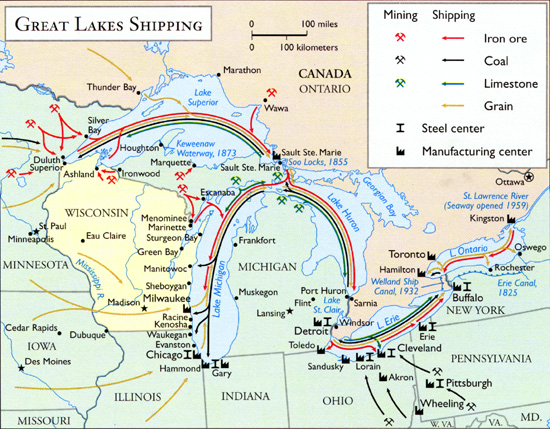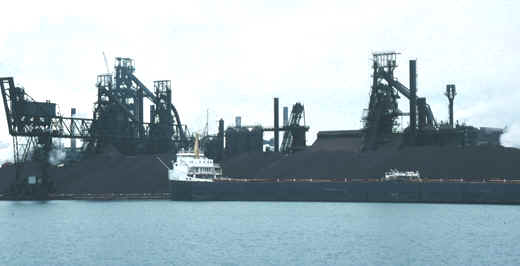IRON AND STEEL
America’s iron industry began along the Atlantic seaboard during the colonial period.
Most of these iron foundries were small and produced iron of inconsistent quality. These
operations came and went rapidly. Demand for iron in America was small and producers’
plants were too modest to realize the advantages associated with economies of scale.
Moreover, they lacked the technical sophistication that allowed Great Britain to dominate
the world iron industry at the time. Poor transportation routes kept producers isolated
from both their sources of raw materials and their markets. They relied on charcoal as
fuel, which had one large disadvantage: the supply was scattered and dwindled once local
timber stands disappeared.
Between 1860 and 1885, American railroads used 1/3 of all iron
produced. Eastern plants, unable or unwilling to modernize, fell even further behind
production schedules under the restraints imposed by east coast mine owners who limited
the amount of ore mined to keep prices artificially high. Therefore, entrepreneurs west of
the Appalachians capitalized on newly discovered coal and ore deposits.
Location, location, location....
The proximity of fuel (coal, coke and charcoal) to the center of iron production remained
the most important influence on the location of 19th-century iron plants. Since the fuel
was bulky and also had a tendency to deteriorate, transport costs for long distances were
often prohibitive. Thus, convenient fuel resources favored the development of the iron
industry near the Pennsylvania coal fields south of Pittsburgh. A similar situation
existed in Alabama. Here, an iron production center developed around Birmingham, where
local iron and coal deposits existed. Unfortunately, the coal contained a high level of
sulphur and produced an inferior grade of iron.
The only other known deposit of ore lay in the inhospitable forests
near the southern shore of Lake Superior. Nonetheless, when William Burt and his surveying
team discovered iron ore along the southern Lake Superior shore in
1844, it hardly caused a stir. In fact, none of the party even bothered to file a claim on
any portion of the area. "The cause of this indifference," wrote one historian,
"doubtless lay in the knowledge of the almost insuperable obstacles which would have
to be overcome before the iron could reach market." These impediments became
painfully evident to the Jackson Mining Company, the first iron mine in Michigan. In
February 1847 it established a forge near their mine to smelt the ore into transportable
bars of rough iron called "blooms." Investors hoped that shipping iron in this
form to Pittsburgh might make the venture profitable. But transportation costs (fuel)
pushed the company’s completed cost per ton to $200, while the market price at the
time was $80. In sum, the Jackson Mining Company did not have the financial and
engineering capabilities to overcome the problem of distance between the Lake Superior
iron ore deposits and the steel mills far to the south. During the second half of the
century, however, three interrelated developments opened the region.
Because the Jackson Mining Company operated in an isolated and desolate
area 20-30 miles from the lake, they found it difficult to transport supplies into the
region and ore out. Initially, they relied only on sleighs in the winter to haul supplies
and ore. (The heavy ore sank wagons into the soft topsoil at any other time of the year.)
Later, a few primitive roads connected the mines with the lakeshore. Railroads were
decades away and even then proved unprofitable. Water offered company officials the only
economical option for transporting their ore southward. But there was a major snag---the
falls of the St. Marys River at Sault Ste. Marie. The inconvenience at the falls caused
time delays, driving up transport costs. For centuries Native Americans congregated there
to fish and trade, portaging their canoes around the rapids. In the 19th
century, portaging ore-filled boats was out of the question. Workers had to unload both
upbound and downbound ships, haul the cargo 1.25 miles around the falls, and reload it
aboard another vessel. Occasionally, teams of men and horses dragged entire ships out of
the water and towed them around the falls on rollers.
Thus, it comes as no surprise that, shortly after Michigan attained
statehood in 1837, government representatives appealed for federal government funds to
build a canal around the falls. With congressional support from the lower Mississippi
River states, canal proponents finally received the necessary support in 1853. The canal
opened on schedule in June 1855. The opening of the canal, named the Michigan State
Locks, but eventually called simply the Soo Locks, perfectly
coincided with the increased demand for iron as railroads expanded westward. Between 1850
and 1860, the railroad network in the United States nearly quadrupled in size. The new
locks expedited the shipment of much-needed iron ore to steel mills in the southern Great
Lakes. In return, investment capital flowed north to the Lake Superior region, expanding
mining operations and improving transportation arteries.

Source: Unknown
The Civil War increased the need for Lake Superior iron, and the volume of shipment began
a steady increase, with additional mines opening on the range. In 1861, the output for the
Marquette Range was 120,000 tons; by 1868, annual figures had reached a half million tons;
and, by 1873, the range produced over one million tons of ore, a figure that steadily
increased through the turn of the century.
How important were iron and steel?
In 1926 economist J. Russell Smith observed that in the United States economy "a
thousand industries must have iron and steel or they cannot go on." The railroad, the
catalyst for the iron industry’s early growth, connected communities across the
country with its network of iron and, later, steel. A large number of these cities, in
turn, produced items of iron and steel transferred by the trains: farm equipment from
Cyrus McCormick’s Chicago factory to rural areas of the Midwest and Great Plains, the
revolutionary typewriter from New York to offices around the country and spools of barbed
wire from midwestern plants to the Great Plains.
The importance of iron in settling the Great Plains during the Gilded
Age is apparent in a letter dated 28 August 1877 by Kansas homesteader Howard Ruede. In
the letter, he provided an inventory of his worldly possessions for his family in
Pennsylvania, listing besides food and staples, "stove, tin wash boiler, 2 iron pots,
teakettle, 2 spiders (a cast-iron frying pan with short legs to stand among coals on the
hearth). 3 griddles, 3 bread pans, 2 tin cups, a steamer, coffee pot, coal oil can,
gridiron, wash basin and 2 lb. Nails." Although Ruede could not then afford one, he
referred frequently to his neighbors’ plows and how important it was for him to
purchase one. He wrote of the various iron tools he used-axes, shovels and pitchforks.
With few exceptions, everything Ruede mentioned was made of iron.
In larger cities, iron and steel made architectural creations possible.
The Commercial Style that emerged in the 1870s relied on iron beams for strength. The
increased used of steel girders and beams allowed further architectural innovations,
culminating in the mighty skyscraper. A growing United States presence, first in the
western hemisphere and later worldwide required a plentiful supply of high-grade steel.
Both battleships and iron-carrying vessels sailing from the Lake Superior mines made use
of steel construction.
These uses made iron production an indispensable ingredient in
America’s national economic growth. Although many factors contributed to the
development of the iron and steel industry, it is difficult to imagine one more critical
than ore carriers, given the geographic proximity of the components necessary for iron and
steel production near the shores of the Great Lakes.

Source: Photograph by Randy Schaetzl, Professor of Geography - Michigan State University
This material has been compiled for educational use only, and
may not be reproduced without permission. One copy may be printed for personal
use. Please contact Randall Schaetzl (soils@msu.edu)
for more information or permissions.